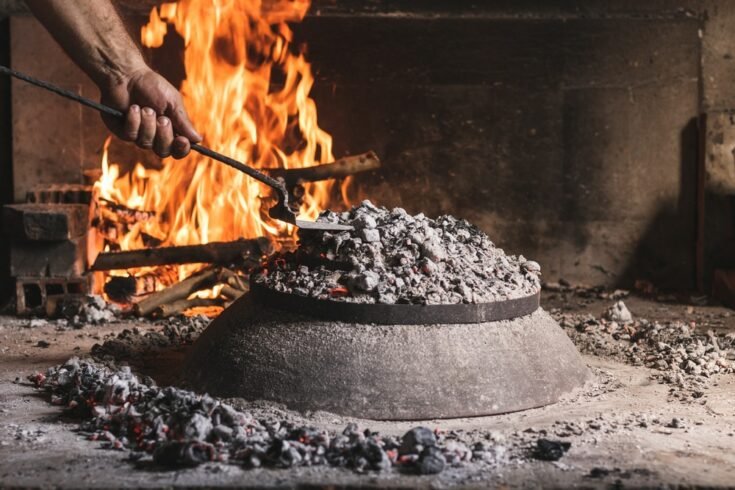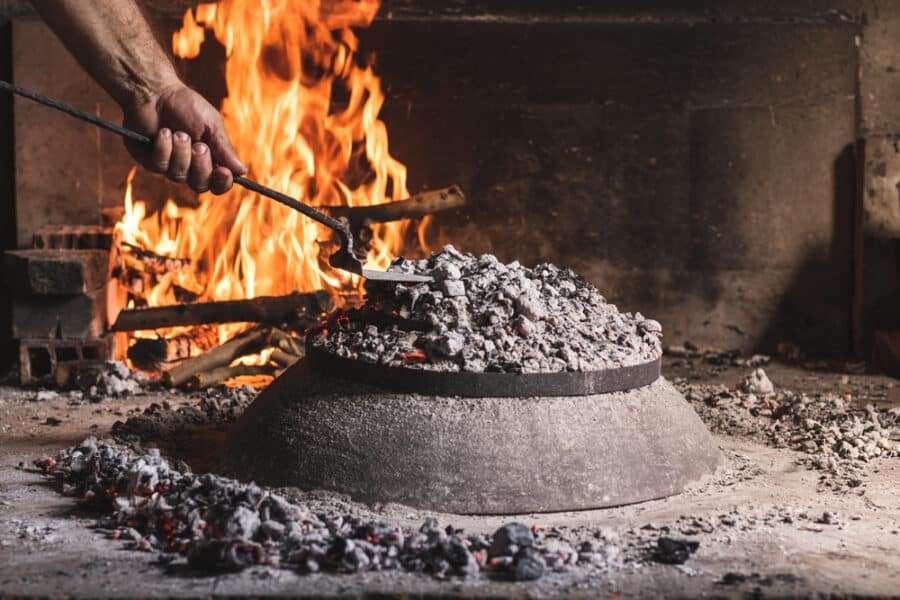Croatian cooking is at its very best with what is known as “under the lid.” Depending on which part of Croatia you live in, it is a literal translation of what we here in Croatia call “ispod čripnje” or “ispod peke”.
Ispod čripnje is essentially food cooked under extreme heat using a terracotta lid and burning wood embers. Ispod peke is our favorite way of cooking, which, along with grilled fish, requires very few ingredients and an open fire.
It is such a vital cooking method here in Croatia; we highly recommend trying your hand at it when visiting by taking this food & wine tour + cooking class near Zadar.

Under The Bell Recipe (Ispod čripnje/Peke)
Master Croatian cooking, with the dish known as ispod čripnje or ispod peke. This traditional style of cooking is explained in as easy to understand way.
Ingredients
- 2 kg Potatoes (4.4 lbs)
- Vegeta
- Extra Virgin Olive Oil (EVOO)
- Crushed garlic
- Vegetables - onions, carrots, peppers/paprikas
- Rosemary
- Bay Leaf
Options
- Seafood: Squid, cuttlefish or octopus.
- Meat: Veal, chicken, pork or lamb
- Vegetables - including a vegetarian option
- Plus: Bread
Instructions
Prepare
- Start your fire approximately one hour before you wish to start cooking. There are two important things to do here. In a large bowl, mix 2 kg of peeled potatoes, which have been cut into quarters lengthways. Season with Vegeta & good quality Extra Virgin Olive Oil (EVOO)
- Ensure you hang the čripnje lid/bell over the fire so it will heat up
- Make the fire in the same spot you will place the tray of meat and potatoes. The concrete below needs to be heated up as well
- Layer the potatoes, in a wide, yet shallow metal pan
- Season your meat with Vegeta, and coat with more EVOO and crushed garlic
- Place the meat on top of the potatoes
- You can also arrange around the meat, seasonal vegetables, such as onions, carrots, peppers/paprikas cut into quarters
- Throw in a few sprigs of rosemary and a bay leaf
Fire it up
- Place your metal pan in the cooking area, and cover with the lid/bell
- Cover the lid/bell with your wood embers, this will create a seal
- Leave it to cook. It's usually at this point a glass of domace rakija {home made brandy} is enjoyed
Skip Ahead To My Advice Here!
What Can You Cook Under Your Bell

Just like with lots of things in Croatian cooking, you eat what is in season.
This means any number of mouthwatering meals can be prepared using this method.
Favorites of ours here in the Adriatic are:
- Seafood: squid, cuttlefish, or octopus
- Meat: veal, chicken, pork & lamb
- Vegetables: here, you’ll find a vegetarian peka recipe
- Plus: bread
No matter what you choose, I have not yet seen any ispod čripnje/peke cooked without a huge serving of potatoes, which are also cooked alongside the meat of choice.
Brands We Use And Trust
Tips From Our Kitchen To Yours
- Let me warn you upfront that this type of Croatian cooking, while simple to prepare, is tricky to master. Why? Because it’s all in the timing. Once you have placed your embers on top of your terracotta dome, it’s unlike an oven or pot, where you can peek inside. You’re blind; you can no longer see what you are cooking or if it’s ready.
- Keep some wood burning on the side in case you need additional embers during the cooking process.
- To be able to make this dish, you need an outdoor cooking area. In Croatia, most village houses have an outdoor kitchen known as a crna kuhinja (black kitchen). But never fear, when we lived in Australia, we set up a make-shift one in the backyard, so you can too
How Long Does A Peka Take To Cook
I have asked all of those in the know & they all tell me that the timings can’t be explained. Seems to me that it’s more a case of intuition rather than that of a stopwatch. So I say to you, give it a go, and know that practice will make perfect.
If you’re like me and you need to know a rough guide, I timed the last few that were prepped, and they took around 45-60 minutes.
This video shows you just how fantastic cooking under the lid is; it was prepared by Mislav Šutalo.
The Deep Roots Of Peka
Imagine a cooking method so old it’s practically prehistoric, yet it’s still rocking the culinary scene in Croatia and beyond. That’s peka for you! It’s not just some recent trend; it’s been around since the Neolithic era, finding its way through various parts of Eastern Europe.
Nowadays, though it’s not your everyday household method, peka still holds a special place in Croatia, especially in restaurants serving up traditional dishes.
The Craft Of Peka
So, the peka is basically this dome-shaped lid used for cooking, right? Back in the day, Croatian potters shaped these bad boys on a manual wheel, creating what’s known as cripnja or pekva.
But then, the Ottomans rolled in with their iron version called sač. These days, while open hearths might be a thing of the past in rural homes, pekas are still the star in many Croatian restaurants and kitchens.
More Than Just Cooking
Is it now, cooking with a peka? It’s not just about tossing ingredients together. It’s an event, a social gathering, a chance to bond with friends and family.
It would be best if you had patience, teamwork, and a bit of skill to get it right. There’s this cool sense of togetherness when you’re all waiting for that delicious slow-cooked meal to be ready. It’s kind of like a barbecue but with its unique twist.
Peka On The Menu
Don’t have a peka master in your circle? No worries! Head to a traditional Croatian restaurant, and you’re likely to find this amazing dish on the menu.
What’s cool is that depending on where you are in Croatia, you’ll get different takes on the peka. Some places might lean more towards meat, others towards seafood. It’s like a culinary adventure waiting for you to explore!
Ispod Peka FAQs
What does “ispod peka” mean?
“Ispod peka” means “under the lid” or “under the bell” in English. It refers to the method of cooking this dish, which involves placing meat, vegetables, and herbs under a bell-like dome or lid, called peka in Dalmatia or čripnja in Istria.
What is the traditional way to cook isp od peka?
The traditional method involves preparing the meat, vegetables, and seasonings in a large metal baking dish. The dish is then placed under the peka lid, covered with hot coals and embers, and left to slow cook for 2-3 hours in an open fireplace or on a heated surface.
What are the main ingredients used in isp od peka?
Ispod peka typically consists of meat (such as lamb, veal, chicken, or octopus), potatoes, onions, carrots, and other vegetables. Olive oil, white wine, rosemary, bay leaves, and black pepper are common seasonings added for flavor.
Can isp od peka be prepared in a cast iron dish?
Yes, a cast iron dish can be used as an alternative to the traditional metal baking dish. It provides a similar cooking environment and helps distribute heat evenly.
What are some popular variations of isp od peka?
Teletina ispod peke (veal under the bell) and kruh ispod peke (bread under the bell) are popular variations of this dish. Each offers a unique taste and cooking experience.
Do Croatian families commonly prepare Ispod peka?
Yes, isp od peka is a beloved traditional dish in Croatian cuisine, often prepared by families, especially in Croatia’s Dalmatia region. It is a celebratory meal commonly enjoyed on special occasions.
Can isp od peka be cooked outside of Croatia?
Absolutely! While traditionally associated with Croatia, isp od peka can be prepared in other locations. The cooking technique can be adapted to different settings, allowing people around the world to enjoy this delicious dish.
Have you ever tried this? How did it turn out? Any tips we’re missing to make it even better? Share your thoughts in the comment box below.


This looks amazing! I bet mastering it is quite an art, though!
Thanks Leanna. Yup it takes a few goes to get it ‘just right’. Once you do, you’re addicted!
Hi does anyone know where i can buy a peka in Perth
Definitely an art to master it without being able to peek. I’m such a dabbler in the kitchen! (Except when I get so distracted it just burns). Looks like it would be reasonably forgiving to a bit of variation, though (within reason).
I’m so happy to see that this technique would work well for vegetarians. And thank you for the link to the vegetarian Peka. I’m excited to try this out!
Totally! And lease do try this and come back let us know. I have not yet tried this as yet myself.
Hi Aussies, I live in Viskovo near to Rijeka in a big family house. We have a konobar with an inside open roštilj and also one outside. We use the pekar often especially when friends and family are visiting. The food always turns out beautiful and such a relaxing way of cooking. A tip for lifting the lid: we have attached a chain and pully system so the lid can be lifted to check the food and or add more of our wine or water, nice and safe.
LOVE THAT TIP!!!
My great grandfather use to say,do not lift up peka any more than once,that means 1hour and 15 minutes,lift up peka,then put meat on the top of potatos,put peka back down for another 30 to 40 minutes,its not nice to let air in to peka
another tip,always put meat first, then potatos,after 1hour 15 minutes put meat on the top of potatos
Can anyone suggest a supplier in Australia! Mum and dad are building a wood fire oven and I would love to get them one.
We never found one when we lived there – but go and ask your local Croatia butcher/store – they may able to advise.
we have a saying
we love peka because everything under peka is good :-D
This is very similar to cooking with a kamado or ceramic cooker ie Big Green Egg or Kamado Joe. Moisture is maintained incredibly and food is much less likely to dry out. It is easier with kamados but this is truly an art form.
We make the same thing in Canada. We call it “ispod saca (sacha)” or my husband says “ispod peke” (peka is the good meat we use.
Thanks for the great pictures!!! Making me hAngry.